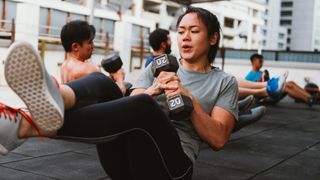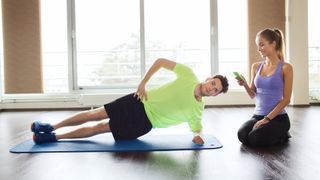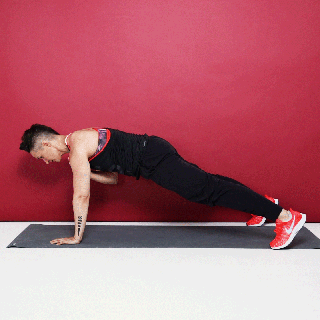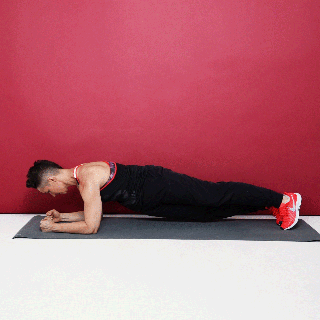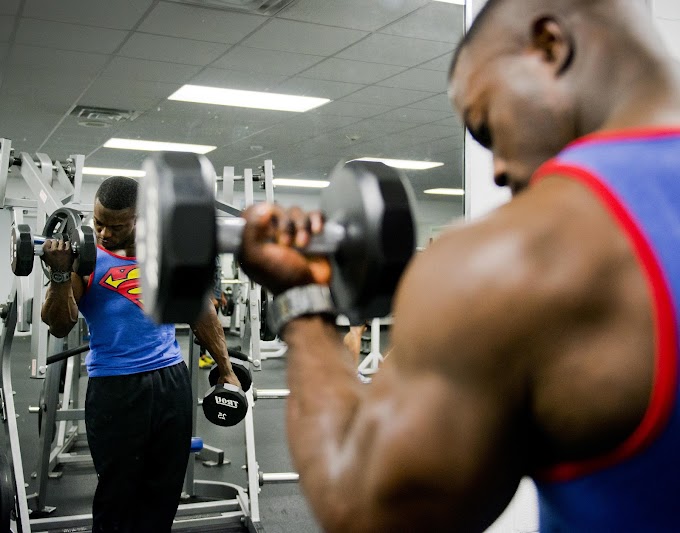Best Abs Exercises 5 Best Abs Workout You Can Do Without Equipment as a Beginner
Best Abs Workout to Get Started
The list consists of the best ab exercises for men and the ab workouts for women. Each of these is important, and together they become a full ab workout.
1. Forward Crunches
The forward Crunch exercise is one of the best upper ab exercises, which can produce some exceptional results. They have an impact on the abdominal area and burn fat very quickly. Follow the steps given below to perform this quick ab workout:
- Lie flat on the exercise mat; legs bowed, where your knees will be facing the sky.
- Hands behind your head for balance.
- Crunch forward while squeezing the abdominal muscle below the ribcage.
- In this move, your upper and middle back, crunch forward to squeeze your upper abs. The lower back ought to stay flat on the ground.
- After reaching the peak of squeezing, return to a neutral posture. And keep doing this until you complete the set.
- Make sure you breathe in when going up and breathe out while going back to lay your head down.
Do 3 sets of 12 crunches on your first day, and increase them with time. During this abs workout at home, make sure that you feel pressure in your abdominal area.
Abs exercises aren't just important for six-pack seekers visiting the gym. Strong abs are an integral part of a rock-solid core, which should be one of the goals of any fitness regime.
That’s because a strong core is the foundation upon which so many other things rest – whether that’s good posture that helps to prevent lower back pain developing from sitting at a desk all day, or the mobility and strength required to excel in sports and other activities ranging all the way from athletics to Zumba.
Using abs exercises to form a mighty midriff will also help you perform better when doing all manner of other moves in the gym. Powerhouse lifts like barbell squats and deadlifts all demand a strong core, as do agility workouts and plyometric exercises.
So the list of benefits of adding abs exercises to your gym repertoire and strengthening your core is almost endless. And who’s going to complain if you also happen to sculpt a picture-perfect six-pack at the same time?
Expert Advice On The Best Abs Exercises For You
Plank

An all-time core classic. Hold a straight line from your shoulders to your ankles while supporting yourself on your forearms and toes.
“The plank is great for beginners and there is minimal movement so less chance of getting it wrong,” says Chamberlain.
“It’s also easy to scale – start at 20-second holds and work up towards 60 seconds. Make sure you engage your core by tilting your pelvis back slightly to flatten your lower back – a curved lower back is to be avoided.”
Hand slide crunch
Lie down with your feet flat on the ground and knees bent. Place your hands on your thighs and slowly slide them up towards your knees as you sit up.
“This does not have to be a large movement,” says Chamberlain. “Focus on closing the distance between your ribs and hips by lifting your shoulders off the floor while maintaining contact between the ground and your lower back.
“Moving the top half up puts more emphasis on your upper abs. Start with sets of five and work towards 15.”
Mountain climber

“Start in a straight arm press-up position with one knee up between your elbows and only the back foot on the floor,” says Chamberlain. “Jump the back foot off the floor and swap it with the front foot.
“Focus on pulling your stomach muscles in throughout the movement to protect your spine and add more intensity. This is a great exercise for burning calories as well as developing your abs. Start with 30 seconds of mountain climbers and work towards 60 seconds.”
Reverse crunch

The reverse crunch is even better than the standard crunch for strengthening your abs. The move keeps your muscles under tension for a longer period and hits the tricky-to-target lower abs particularly hard.
Lie down and raise your legs so your thighs are vertical and your knees are bent at a 90° angle. Contract your abs to bring your knees to your chest and raise your hips off the floor, then slowly lower your legs back to the start.
Grounded Russian twist

It’s worth mastering the basic version of this exercise because it hits the oft-neglected obliques and often fitness classes throw people in at the deep end with more difficult variations. Sit on the floor with your knees bent and heels resting on the ground. Lean back so that your torso is at 45°. Keep your chest up to stop you from hunching your back. Interlock your fingers and extend your arms in front of you. Turn your torso to the left or right, bringing your hands to touch the ground on that side. Rotate back to centre and then carry on to touch the opposite side. Once you’ve mastered the movement, make it more difficult by raising your heels off the floor and/or holding a weight.
Dead bug

The dead bug is a fine choice for beginners because it goes easy on your neck and back, which can’t be said for other abs exercises when they’re done incorrectly.
Lie on your back with your arms extended to the ceiling. Raise your legs and bend your knees until they’re at 90°. Lower your left arm towards the ground and simultaneously extend your right leg so both limbs end up parallel to the ground. Reverse the movements, then repeat with the other arm and leg. Focus on making your movements slow and controlled, spending three seconds lowering and three seconds raising. Work for 30 to 60 seconds, or three sets of five reps on each side.
Leg raise

Lie down flat on your back on the ground. Keeping your legs as straight as possible, raise them until they’re vertical or as close as you can get. Lower them and repeat.
“This engages your lower abs, and you engage your core by flattening your lower back on the floor,” says Chamberlain.
“To make it easier, tuck your knees in and start with your legs raised, then slowly lower them towards the floor. Once you master this, start keeping your legs straight when returning to the top position.
“If you feel a niggle in your lower back then place your hands under your buttocks to help keep your lower back flat. Start with sets of five raises and work towards 15.”
Hand walk
Get on all fours and place sliders or a towel under your feet, then brace your core and walk your hands forwards, pulling your body along while twisting your hips as little as possible.
“The intensity ramps up quickly so start at 30 seconds and work towards 60 seconds,” says Chamberlain.
Abs roll-out

“Using an abs roller or a barbell with weight plates on, kneel on a soft surface and grab the roller with your hands just wider than shoulder-width apart,” says Chamberlain.
“Start by just slowly rolling the barbell or roller away from your knees. It’s important to have your hips forward so your knees, hips and shoulders all align. Once you have control when rolling away, try to maintain hip and spine position while rolling the weights back in. Try to avoid pushing your hips in the air on the way back because this defeats the purpose of the exercise (although it’s OK to do it when starting out). This is great for improving the strength of your core quickly. Start with five reps and work towards 15.”
Plank with toe tap
This progression from the standard plank is a good way to ensure you’re keeping your core engaged throughout the move, and adding a little controlled movement helps to keep your mind occupied and make the time go by a little quicker while you’re holding the position. Start in the standard plank position supporting your body on your forearms and toes. Raise one foot off the floor and move it to the side, tap the floor with your toes, then come back to the plank position. Throughout the tap action, make sure that you are keeping your body level and not tipping over to either side or sagging your hips. Alternate sides with each rep until you hit your target time.
Bent-knee windshield wiper
Lie flat on your back with your arms spread out to the sides. Lift your legs and bend your knees at a 90° angle. Slowly take your knees over to one side, stopping around 15cm from the floor. Pause for three seconds or so, then bring your legs back up and over to the other side. Move slowly, keep your abs engaged, and make sure you’re not lifting your torso off the floor as you twist.
Bird-dog

As with the beginner abs exercise the dead bug, the bird-dog requires you to move opposite limbs in tandem. But because you’re on all fours rather than lying on your back, it adds a degree of instability for an extra challenge.
On your hands and knees, with your hands below your shoulders and knees below your hips, raise and extend one arm and the opposite leg. Hold the position for a beat, then return slowly to the start. Alternate sides with each rep. For an extra challenge you can add a crunch, bringing your elbow and knee to meet under your torso before regrounding them.
Hanging knee raise

A precursor to the hanging leg raise (below), this pull-up bar exercise focuses on your lower abs. Hang from a bar or gym rings with an overhand grip, palms facing forwards. Brace your abs and use them to raise your knees to your chest. Pause, then lower slowly.
Dumbbell woodchop

This lift with a twist targets your obliques and is a must for golfers in particular, because working on rotational motion will help add power to your swing. Stand holding a dumbbell in both hands. Squat down and move the dumbbell over to the outside of your left thigh. Stand up and raise the dumbbell with straight arms, twisting to take it across your torso to finish above your right shoulder. In the final position you should have twisted your entire torso to face the dumbbell and be up on your toes, using your core to hold the position. Twist back to return the dumbbell to the starting position. Do all the required reps on one side and then swap.
Medicine ball crunch

Lie on your back with your knees bent and feet flat on the floor. Hold a medicine ball – 6kg to 10kg should be fine – to your chest. Raise your torso off the floor and press the medicine ball above your head with straight arms. To encourage good form, bring your head forwards between your arms and keep your chest up as your torso reaches vertical. Slowly lower under control, keeping your arms extended so the medicine ball touches the floor behind your head. Keep the movement smooth and controlled
Walking plank

Adopt the plank position with both forearms on the floor and your body forming a straight line from your shoulders to your ankles. Now push up to the raised plank position one hand at a time. Once you’re up, return to the standard plank position, again one hand at a time. Repeat, changing the hand you lead with each time. The aim is to keep your hips as still as possible – if they start to move, increase the distance between your feet to make it easier. Aim for 30- to 60-second work periods.
Flutter kicks

Sometimes known as scissor kicks, this movement will certainly feel like it’s carving out your abs. Lie on your back and raise your legs so that they’re roughly 15cm above the ground. Keeping your legs straight throughout, move your legs up and down in a kicking motion, with the movement coming from your hips. Go at a pace that’s comfortable and allows you to keep your legs off the ground for the duration, and make smooth and controlled movements. Work for between 30 and 60 seconds at a time.
Pallof press

“There are four main functions of the core: flexion, lateral flexion, isometric contraction and anti-rotation,” says Martin. “There are others – those are just the big four.”
“We tend to cover the first three with various forms of crunches (flexion), side bends (lateral flexion) and planks (isometric contraction). The Pallof press sits in the anti-rotation bracket, with a touch of isometric contraction.
“Set up a cable machine with a D-handle at about chest height. Stand side-on to the cable machine and hold the handle with both hands, fingers interlocked. The start position is holding the handle by the centre of your rib cage. Bend your knees slightly and extend the cable out until your arms are straight. Pause for a count of two – the objective here is not to let the weight on the machine pull you around, so you resist the rotation using your core. Bring the handle back to your chest and repeat for ten reps.”
Hollow body rock

“We often neglect the muscles we can't see, especially with midsection training,” says Martin. “This exercise works the inner core muscles.
“Start lying on your back – the goal is to flatten your back or push it into the floor. Maintain this position throughout the whole movement. Bend your knees and place your feet on the floor. Begin by lifting your shoulders off the floor, and at the same time lift your knees and feet off the floor to a 90° angle. While maintaining this position with your back pressed into the ground, start to rock back and forth. Start with 20 seconds to begin with. To make the exercise more challenging, you can extend the time, and also try increasing the lever length by straightening your legs and extending your arms overhead.”
Hanging leg raise with split

“This is great for lower abs development,” says Chamberlain. “Start by hanging off a bar or putting your elbows in abs stirrups. Keeping your legs locked straight, slowly raise your feet until they are at hip height. Pause for a second, then split your legs as wide as possible. Hold this position for a second, then close your legs and slowly lower them to the starting position. Start with ten reps and work towards 20.”
Rainbow slider
“Start in a straight arm press-up position with sliders or a towel under your feet. Both of your feet should be slightly to one side.
“Draw your knees in to your chest without raising your hips, then push your feet away to the other side. The slower you move, the harder this drill is. Start with ten reps and work up to 20.”
Dual weighted crunch
“Start in a tensed bowl position with your heels and shoulders off the floor,” says Chamberlain. “Balance a 5kg plate on your shins and hold a 5kg plate in your hands, arms extended overhead. Pull your knees in to your chest while sitting up until the two plates are aligned one over the other, then slowly return to the tensed bowl position with your arms extended overhead.
“You have to move slowly so as not to drop the balanced plate, which adds to the intensity of the exercise. Start at ten reps and work towards 20. Once you hit 20 increase the weight. This is a very tough exercise but it’s really gratifying when you can hit 20 at a time, plus it’s easy to scale to make it harder.”
V-sit

This tricky sit-up variation engages both the upper and lower abs, making it an efficient way to work on that six-pack. Lie on your back with your arms extended behind your head. Raise your torso and extended legs, while bringing your extended arms over your head and reaching them towards your toes.
Dragon flag

You know an exercise is hard when it makes a Rocky montage, and the Italian Stallion used the dragon flag to prepare for his bout with Ivan Drago in Rocky IV. Lie back on the bench and grasp both sides of the bench by your ears. Engage your core and lift your legs so your toes point at the ceiling. Your body should form a straight line from your feet to your chest, with only your upper chest and shoulders still touching the bench. Lower slowly back to the start, making sure your back doesn’t arch.
L-sit

While to the untrained eye this looks easy, it is L on the abs. Start sitting on the floor with your legs together and extended. Place your palms on the ground with your fingers pointing forwards. Brace your abs, glutes and legs and press through your palms to lift your body off the ground – you’re now the most uncomfortable L on the planet. Getting off the floor is an achievement in itself, but work towards holding the position for ten seconds.
Bicycle Crunch

A study commissioned by the American Council on Exercise named this the best abs exercise because it provides the greatest stimulus to both abs and obliques. That’s more bang for your buck, or more aches for your effort depending on your point of view.
Lie on your back, extend your legs and hold them just above the ground. Place your fingers lightly on your temples. Bring one knee up towards your chest and twist your torso so that the opposite elbow comes over towards it. Your elbow and knee needn’t touch, but thinking of that connection between the two body parts is a good way to guide the movement of your torso. Lower both your torso and leg at the same time, then repeat on the opposite side. Keep the movement continuous and smooth for 30 to 60 seconds at a time.
